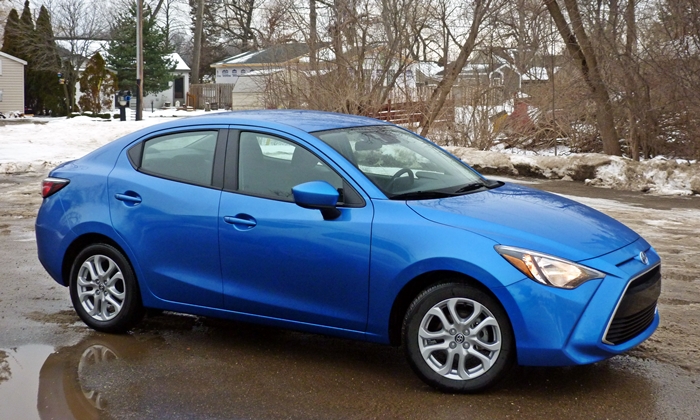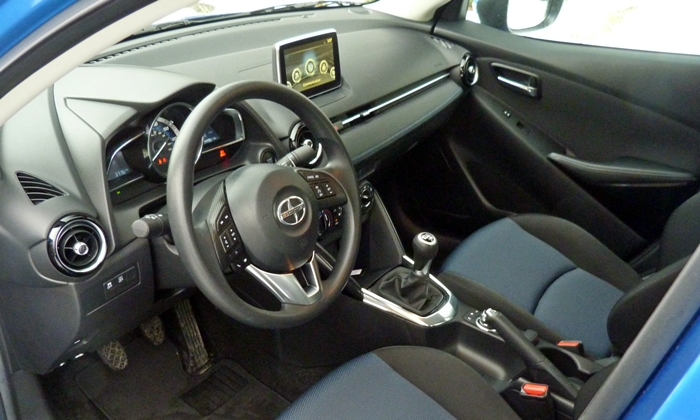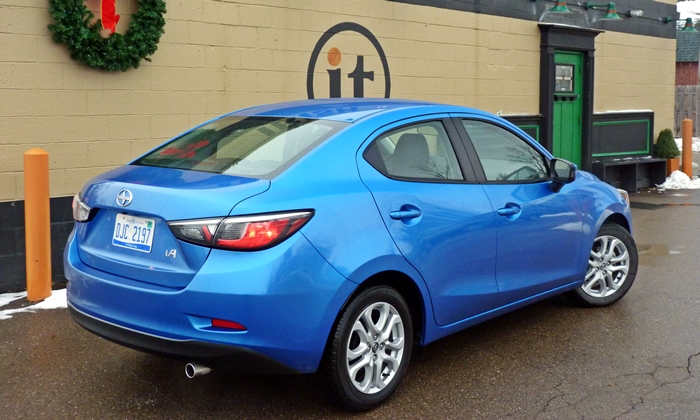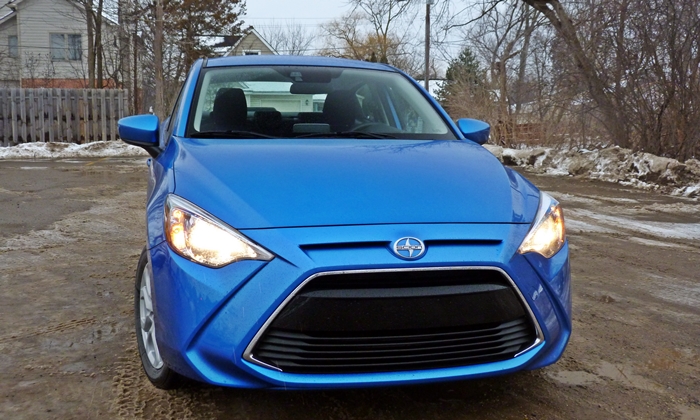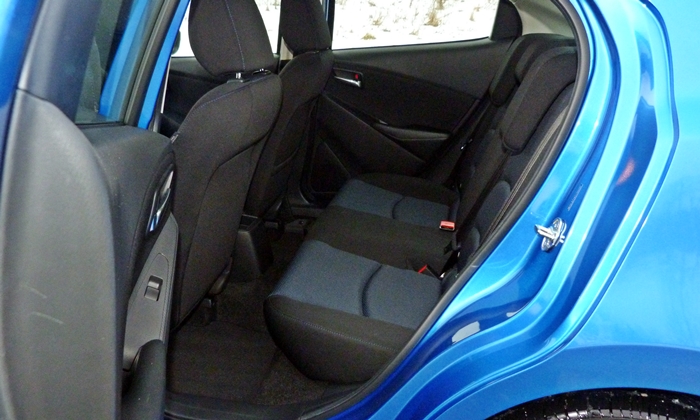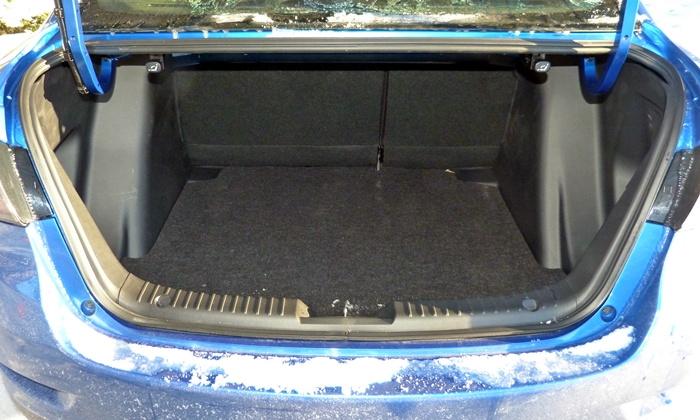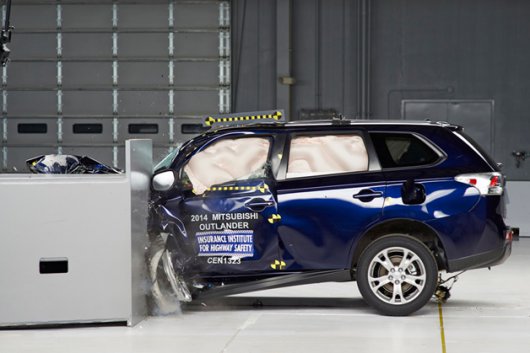Краш-тест 2016 Scion iA
Scion iM 2016: молодежный хэтчбек с уклоном на спортивность
 Обзор Scion iM 2016: внешний вид модели, интерьер, технические характеристики, системы безопасности, цены и комплектации. В конце статьи — тест-драйв Scion iM 2016 года! Обзор Scion iM 2016: внешний вид модели, интерьер, технические характеристики, системы безопасности, цены и комплектации. В конце статьи — тест-драйв Scion iM 2016 года!
Обзор Scion iM 2016: внешний вид модели, интерьер, технические характеристики, системы безопасности, цены и комплектации. В конце статьи — тест-драйв Scion iM 2016 года! Обзор Scion iM 2016: внешний вид модели, интерьер, технические характеристики, системы безопасности, цены и комплектации. В конце статьи — тест-драйв Scion iM 2016 года!

Автомобильный бренд Scion малоизвестен на российском рынке — впрочем, это и не удивительно, так как компания создавалась специально для американского потребителя.
Scion («Сайон») является суббрендом японского автоконцерна Toyota, который был создан в середине 2002 года и позиционируется как производитель молодежных автомобилей. В начале 2016 года руководством Toyota было принято волевое решение о закрытии марки, которое пришлось на август 2016 года, а уже с начала 2017 года автомобили «Сайон» будут реализовываться под брендом своего прародителя.
Последней моделью марки Scion стала модель iM, которая впервые была показана в ноябре 2014 г. в рамках Лос-Анджелесской автомобильной выставки. Сразу стоит отметить, что автомобиль не стал откровением и являет собой несколько перелицованный Toyota Auris второй генерации, получивший более агрессивную внешность, которая непременно придется по душе молодежи, являющейся основной покупательской аудиторией марки.
В отличие от своего «родителя» автомобиль предлагается только с одним двигателем, при этом потенциальные покупатели могут дополнительно заказать специальный пакет от гоночного подразделения Toyota, включающий в себя переработанную систему впрыска, спортивные амортизаторы и ряд прочих элементов, призванных сделать машину более динамичной.
Экстерьер Scion iM 2016

Новый Scion iM обладает динамичной и стильной внешностью, которая выполнена в лучших традициях последних автомобилей Toyota. Лицевая часть хэтчбека готова похвастать слегка прищуренной головной оптикой с новомодными LED-огнями дневного света, стильной фальшрадиаторной решеткой, рисунок которой в отличие от Auris выполнен в виде пчелиных сот, а также спортивным передним бампером с огромным воздухозаборником.
При взгляде на профиль хэтчбека нельзя не отметить наличие заваленного в направлении кормы ветрового стекла, благодаря которому коэффициент лобового сопротивления удалось снизить до 0,28 Сх, а также плавно ниспадающей крыши, благодаря чему машина выглядит более динамично и спортивно.
Отдельного внимания заслуживают аккуратные колесные арки, оригинальная задняя стойка треугольной формы и стильные легкосплавные колесные диски. Корма хэтчбека получила компактную дверь багажника, оригинальной формы светотехнику габаритных огней, а также массивный задний бампер с по-спортивному оформленным диффузором, которые лишний раз подчеркивает молодежную направленность марки.
Габариты нового Scion iM составляют:
- В длину – 427,5 см;
В ширину – 176 см;
Колесная база автомобиля равна 260 см, что представляет собой один из лучших показателей в классе. Высота дорожного просвета составляет 120 мм, что на 20 мм ниже, чем у одноплатформенной Toyota Auris, но даже этого достаточно, чтобы автомобиль смог уверенно преодолевать «лежачих полицейских» и въезжать на бордюры.
Нам импонирует внешний облик Scion iM, который буквально настраивает на агрессивный стиль вождения (благо с динамическими характеристиками у хэтчбека все в порядке).
Интерьер хэтчбека Scion iM 2016

Внутреннее убранство новинки полностью повторяет таковое в модели Auris, и это радует, поскольку японцам удалось создать действительно привлекательный, эргономичный и современный интерьер.
Прямо перед водителем располагается трехспицевый мультируль, обеспечивающий удобный хват, а также современная приборная панель с крупными циферблатами показателей скорости и оборотов, а также дисплеем бортового компьютера. Центральная часть торпедо представлена информационно-развлекательным и блоком регулировки микроклимата.
Японцы подчеркивают, что при создании интерьера ими были использованы более качественные материалы отделки, а также улучшена подгонка деталей друг к другу, впрочем, сборка «тойотовских» салонов уже давно ни у кого не вызывает никаких вопросов.

Передние сидения отличаются хорошей эргономикой, а благодаря большому диапазону регулировок с легкостью примут пассажира любой комплекции. Между креслами располагается небольшой подлокотник, у основания которого находится небольшой бокс для различной мелочевки.

Диван второго ряда рассчитан на троих взрослых седоков, при этом свободного места достаточно не только в высоту и ширину, но и в длину.

Объем багажника Сайон iM составляет 360 л., что пусть и не является рекордным показателем в классе, но будет достаточно большей части потенциальных покупателей модели.
Интерьер хэтчбека привлекает качественными материалами отделки, хорошо продуманной эргономикой рабочего места водителя, а также просторным салоном, рассчитанным на пятерых взрослых седоков. Сам производитель подчеркивает, что салон автомобиля за счет улучшенной шумоизоляции и использования современных материалов является одним из самых тихих в классе, и это действительно так.
Технические характеристики Scion iM 2016

В отличие от своего собрата, который предлагает на выбор один из трех бензиновых моторов, двух дизелей или гибридного бензиново-электрического силового агрегата, Scion iM представлен только одним мотором – 1,8-литровым 137-сильным бензиновым двигателем, стандартно агрегатирующимся 6-ступенчатой механической КПП.
За дополнительную плату покупатель может оборудовать машину CVTi-S вариатором, который настроен таким образом, чтобы обеспечить более динамичную и резвую езду. Этот двигатель обеспечивает хэтчбеку неплохие динамические характеристики: разгон от 0 до 100 занимает менее 10 сек, а максималка ограничена отметкой в 195 км/час. Несмотря на спортивный нрав, расход топлива машины варьируется в пределах 5,5-7,5 литров на 100 км пути.
Машина построена на платформе Тойота Аурис первого поколения, что предполагает наличие стоек Макферсон спереди и балки – сзади.
Автомобиль предлагается исключительно в переднеприводной компоновке, однако ходили слухи о том, что модель может получить также полноприводную трансмиссию. Специально для Scion iM японскими инженерами была перенастроена подвеска и амортизаторы, что положительно сказалось на управляемости, однако назвать автомобиль «мягким» нельзя – подвеска хорошо сбита и весьма нервно отрабатывает мелкие неровности.
Впрочем, это никоим образом не портит впечатления от вождения, да и не стоит забывать, что в отличие от «семейно-практичного» Auris, iM настроен как более драйверский автомобиль.
Безопасность Scion iM 2016

Компания Toyota уже давно снискала славу надежных и чрезвычайно безопасных автомобилей, поэтому было бы удивительно, если Scion iM оказался бы другим. Как и подобает современному хэтчбеку, машина оснащена большим количеством электронных помощников, в числе которых:
- Продвинутая антиблокировочная система;
Система курсовой стабилизации;
Система электронного распределения тормозных усилий;
Датчики слежения за «мертвыми» зонами, дорожной разметкой и состоянием водителя;
Система, предотвращающая лобовое столкновение, которая в экстренной ситуации способна самостоятельно замедлить движение автомобиля;
8 подушек безопасности;
Современные 3-х точечные ремни безопасности с преднатяжителями;
Высокие показатели безопасности достигаются также за счет использования более прочных сортов стали, а также расширенным зонам деформации, задача которых — погасить силу удара при лобовом и боковом столкновении.
Примечательно, что Toyota Auris (она же Scion iM) второй генерации уже успела пройти международные краш-тесты EURO NCUP, где завоевала максимальные пять звезд.
Комплектация и цена Scion iM 2016 года

Минимальная цена Scion iM на американском рынке составляет 18,6 тыс. долларов (около 1,14 млн. руб.) за которые покупатель может рассчитывать на следующий уровень оснащения:
- Колесные диски 16 радиуса;
Электропривод стекол всех дверей, а также электрорегулируемые зеркала заднего обзора с системой обогрева;
Тканевая обивка салона;
Аудиосистема с цветным дисплеем;
Продвинутая антиблокировочная система, а также система распределения тормозных усилий и стабилизации;
Панель приборов с цветным дисплеем бортового компьютера;
В более дорогих исполнениях автомобиль дополнительно может комплектоваться:
- Продвинутым мультимедийным комплексом с большим мультитач дисплеем;
Расширенным списком электронных систем безопасности;
За отдельную плату покупателям доступен спорт-пакет TRD, в состав которого входят иная система впуска, амортизаторы, а также усовершенствованные стабилизаторы, отвечающие за поперечную устойчивость хэтчбека.
За топовый вариант исполнения потенциальному покупателю придется расстаться более чем с 25 тыс. долларов.
Заключение о новом Scion iM 2016
Scion iM 2016 модельного года представляет собой несколько улучшенную внешне Toyota Auris, отличающуюся более агрессивной внешностью, по-спортивному настроенной подвеской и рулевым управлением, а также улучшенными динамическими характеристиками.
При этом машина сохранила главные фишки «Аурис»: просторный салон, отменную эргономику рабочего места, вместительный багажник и широкий список стандартного и опционального оборудования.
Тест-драйв Scion iM 2016 года:
2016 Scion iA
minicar / 4-door sedan
Crashworthiness
Crash avoidance & mitigation
Child seat anchors
Other available safety features
- Standard daytime running lights
- G
Some ratings use a scale of Poor to Good. Others range from Basic to Superior.
- Small overlap front: driver-side
- Moderate overlap front
- Side
- Roof strength
- Head restraints & seats
- Front crash prevention: vehicle-to-vehicle
- Child seat anchors
Small overlap front: driver-side
Rating applies to 2016 models
Tested vehicle: 2016 Scion iA 4-door
The Scion iA sedan was introduced in the 2016 model year. It is based on the redesigned 2016 Mazda 2, which is no longer available for sale in the U.S. market.
The Scion iA was renamed the Toyota Yaris iA beginning with the 2017 model year as Toyota discontinued the Scion nameplate. Beginning with the 2019 model year, the «iA» portion of the name was dropped, and beginning with the 2020 model year, a 4-door hatchback variant was added.
Ratings apply to both the hatchback and sedan.
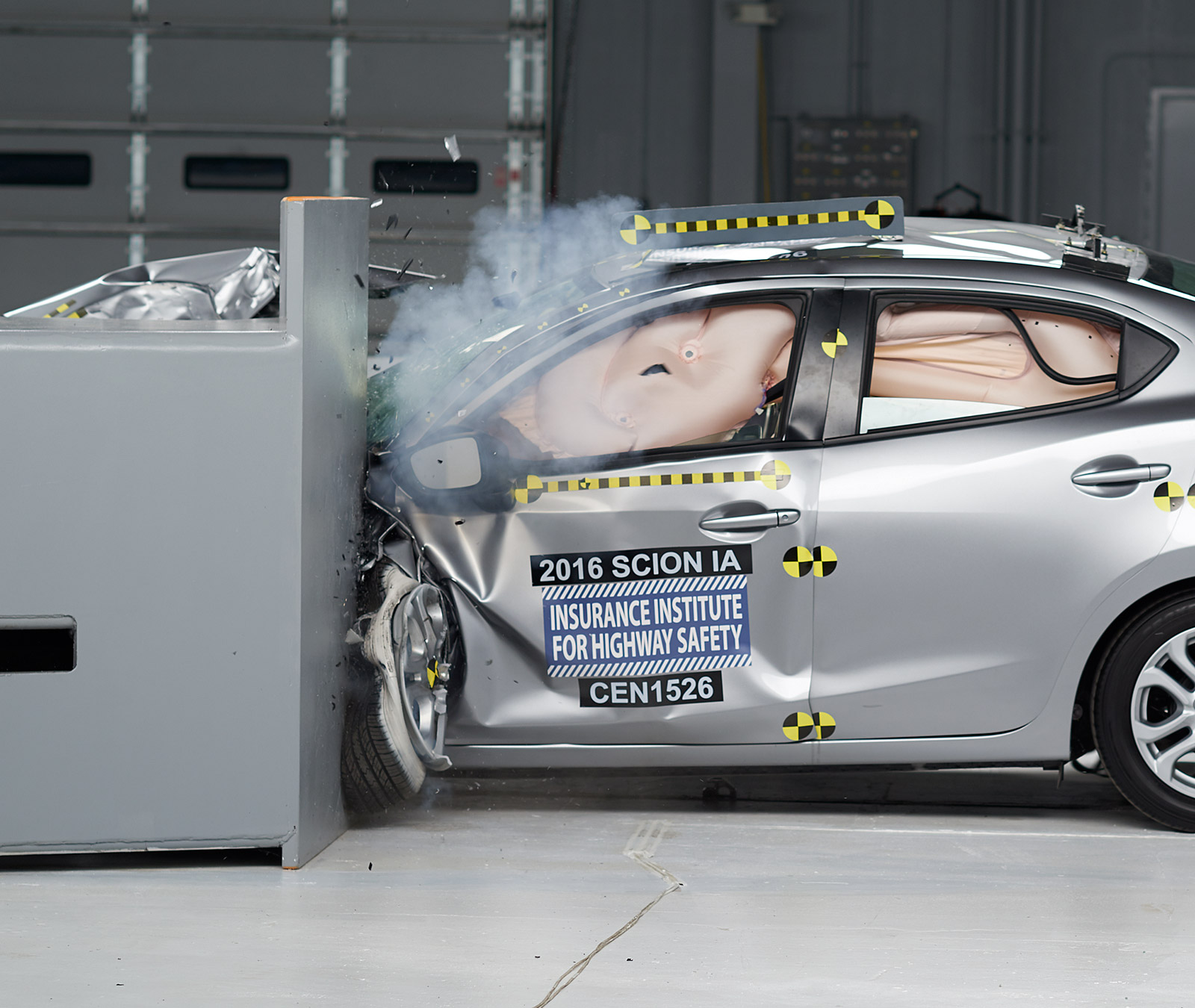
Action shot taken during the small overlap frontal crash test.

The dummy’s position in relation to the door frame, steering wheel, and instrument panel after the crash test indicates that the driver’s survival space was maintained very well.

The frontal and side curtain airbags worked well together to keep the head from coming close to any stiff structure or outside objects that could cause injury.

The driver’s space was maintained well, and risk of injuries to the dummy’s legs and feet was low.
Measures of occupant compartment intrusion on driver side
| Test ID | CEN1526 |
|---|---|
| Lower occupant compartment | |
| Lower hinge pillar max (cm) | 5 |
| Footrest (cm) | 5 |
| Left toepan (cm) | 3 |
| Brake pedal (cm) | 6 |
| Parking brake (cm) | |
| Rocker panel lateral average (cm) | 1 |
| Upper occupant compartment | |
| Steering column | |
| Upper hinge pillar max (cm) | 4 |
| Upper dash (cm) | 4 |
| Lower instrument panel (cm) | 6 |
Driver injury measures
| Test ID | CEN1526 |
|---|---|
| Head | |
| HIC-15 | 124 |
| Peak gs at hard contact | no contact |
| Neck | |
| Tension (kN) | 1.3 |
| Extension bending moment (Nm) | 11 |
| Maximum Nij | 0.26 |
| Chest maximum compression (mm) | 27 |
| Femur (kN) | |
| Left | 0.8 |
| Right | 0.3 |
| Knee displacement (mm) | |
| Left | 2 |
| Right | 1 |
| Knee-thigh-hip injury risk (%) | |
| Left | |
| Right | |
| Maximum tibia index | |
| Left | 0.45 |
| Right | 0.39 |
| Tibia axial force (kN) | |
| Left | 1.9 |
| Right | 0.8 |
| Foot acceleration (g) | |
| Left | 63 |
| Right | 66 |
Moderate overlap front
Rating applies to 2016 models
Tested vehicle: 2016 Scion iA 4-door
The Scion iA sedan was introduced in the 2016 model year. It is based on the redesigned 2016 Mazda 2, which is no longer available for sale in the U.S. market. Moderate overlap frontal ratings are assigned by the Institute based on a test conducted by Mazda as part of frontal crash test verification.
The Scion iA was renamed the Toyota Yaris iA beginning with the 2017 model year as Toyota discontinued the Scion nameplate. Beginning with the 2019 model year, the «iA» portion of the name was dropped, and beginning with the 2020 model year, a 4-door hatchback variant was added.
Ratings apply to both the hatchback and sedan.
2016 Scion iA Test Drive Overview
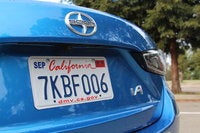
Looking for a Used iA in your area?
CarGurus has 129 nationwide iA listings starting at $7,600.
2016 Scion iA Test Drive Review
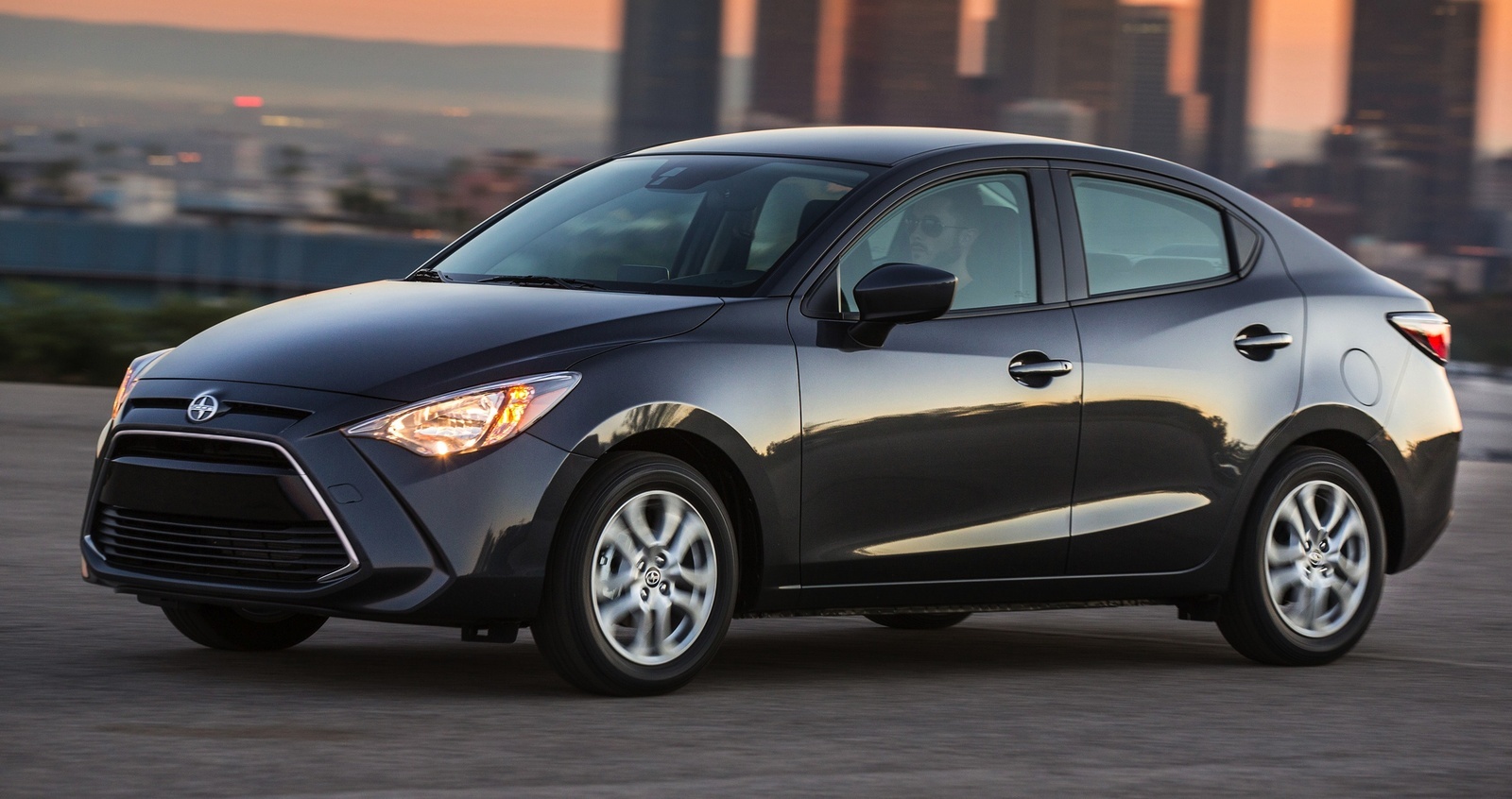
With the Yaris sedan no longer in production, Toyota found itself in need of a replacement and found Mazda had the perfect example in the not-coming-to-U.S.-shores Mazda2. So they paid Mazda to allow them to put it out with Scion badges tacked on. This is a good thing, as the Mazda2 has already impressed with engaging driving dynamics and styling that’s gone a long way toward redefining the subcompact class. Rebadged as the Scion iA, things improve further with more standard features in keeping with Scion’s one-price structure.
Look and Feel
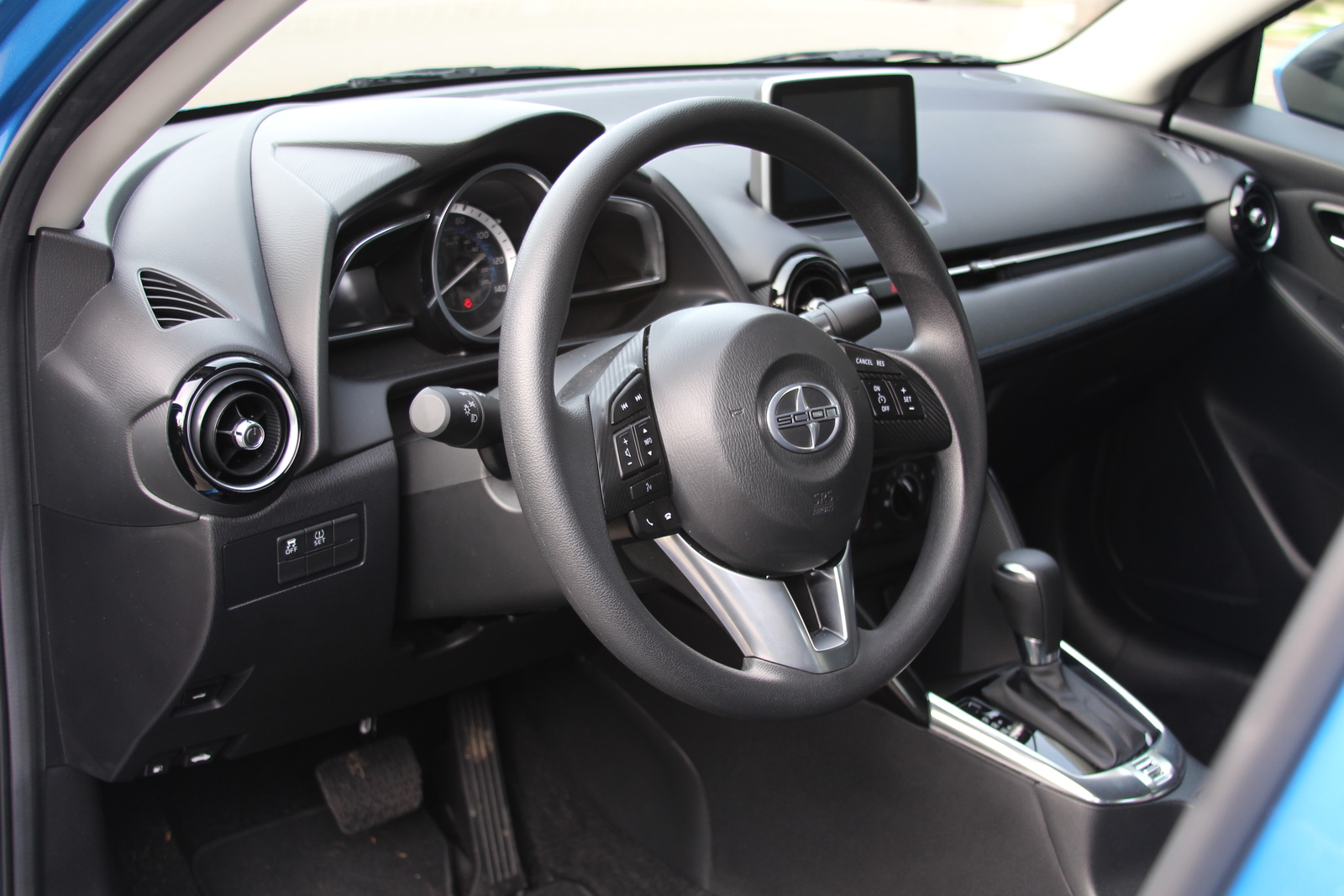
Inside and out, it’s easy to see Mazda stylings in the iA. In fact, it’s curious that Toyota was so willing to simply re-badge, as Mazda’s design language stands out quite dramatically, and this is no exception. Swooping lines along the flanks and interior layout are so frankly Mazda, I would’ve been concerned about brand confusion. Regardless, what this means is an invigorated offering for Toyota/Scion in the subcompact class.
The energetic lines of Mazda have been slightly divisive, with some feeling they go too far, especially with the dramatic swoops that grace the flanks. Others find those same distinctive elements the very thing that sets Mazda apart in a landscape of offerings where few design chances are taken. That aside, the iA offers a classic sedan profile that feels only mildly squashed in subcompact form. Hit the starter button and a graphic representation of the car’s profile shows on the 7-inch touchscreen sitting atop the clean dash. Aero vents again hint at considerations above the price point, a theme carried over into the driving dynamics.
There, things are truly Mazda. It’s a surprising discovery in the class, where buyers usually need to give up on the idea of actually enjoying driving. Here there are no such compromises necessary, and while not a sports car, there’s more than just city commuting to the iA.
With an MSRP of $16,495 for an iA with the 6-speed manual ($770 delivery fee included), the only option to be added was the $1,100 6-speed automatic, bringing the total price to $17,595. Scion prides itself on its one-price structure, so options are limited, but navigation can be added for $419.
Performance
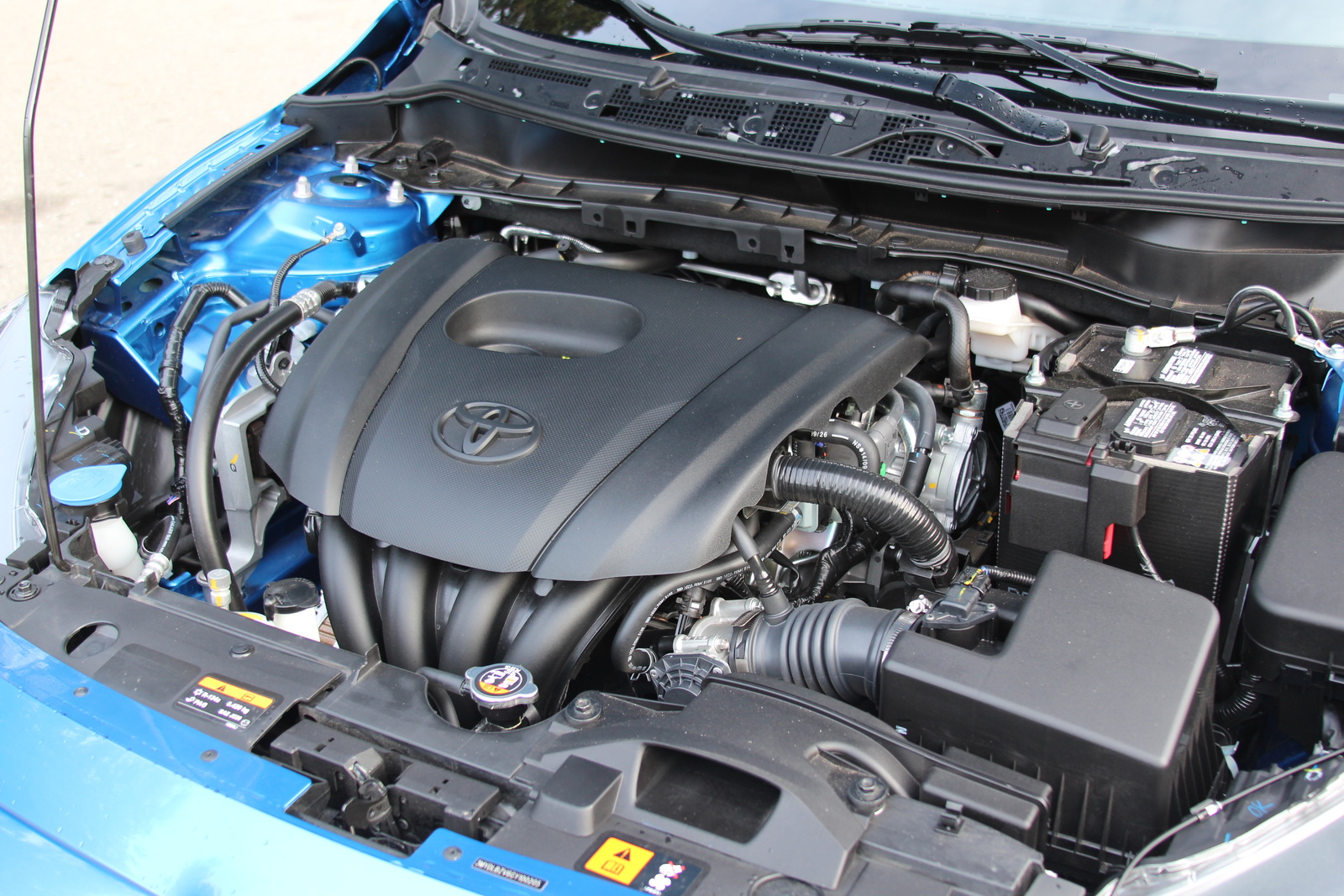
With a high-revving, 16-valve, 1.5-liter inline 4-cylinder, the iA puts up numbers that just coast past 100: 106 hp and 103 lb-ft of torque, to be precise. With a curb weight of just 2,400 pounds, this should be more than enough to motivate, but it’s the delivery that has this engine falling just a bit short. The torque doesn’t arrive until 4,000 rpm, and the horsepower waits another 2,000 to hit its peak. While this engine is happy to rev, this still means that stop-and-go driving — the kind you’re most likely to encounter in the city — can get rather tiring as you have to rev the hell out of the engine just to get things going. It’s bad enough on flat streets, but on the hilly roads of the Bay area, things got even worse. I certainly don’t mind revving, but when one of the major selling points of a vehicle is its fuel economy — 33 mpg city/42 highway/37 combined — having to push the engine like this every time you want to come away from a stop absolutely kills those figures. Consequently, I wasn’t able to come close to 37 mpg during my week with the iA. The manual transmission would help significantly, I think, in both the fun factor and economy, and thankfully reports have stated the manual transmission here is very easy to operate.
That said, once you get the car out on back roads and can keep those revs high, the engine really shines in its power band. That’s where the math of a hair over 100 hp/lb-ft and a 2,400-pound curb weight finally makes sense. More than that, the iA has the handling to keep things interesting as you shoot through curves with the engine running at more than 4 grand. Yes, the iA is built with a MacPherson strut front and torsion-beam rear suspension, and that’s a setup that would be found lacking in a 3,500- or 4,000-pound car. But in a car with 1,000 fewer pounds coupled with a solid, balanced chassis and well-weighted steering, there’s more fun to be had here than you’d expect.
Form and Function
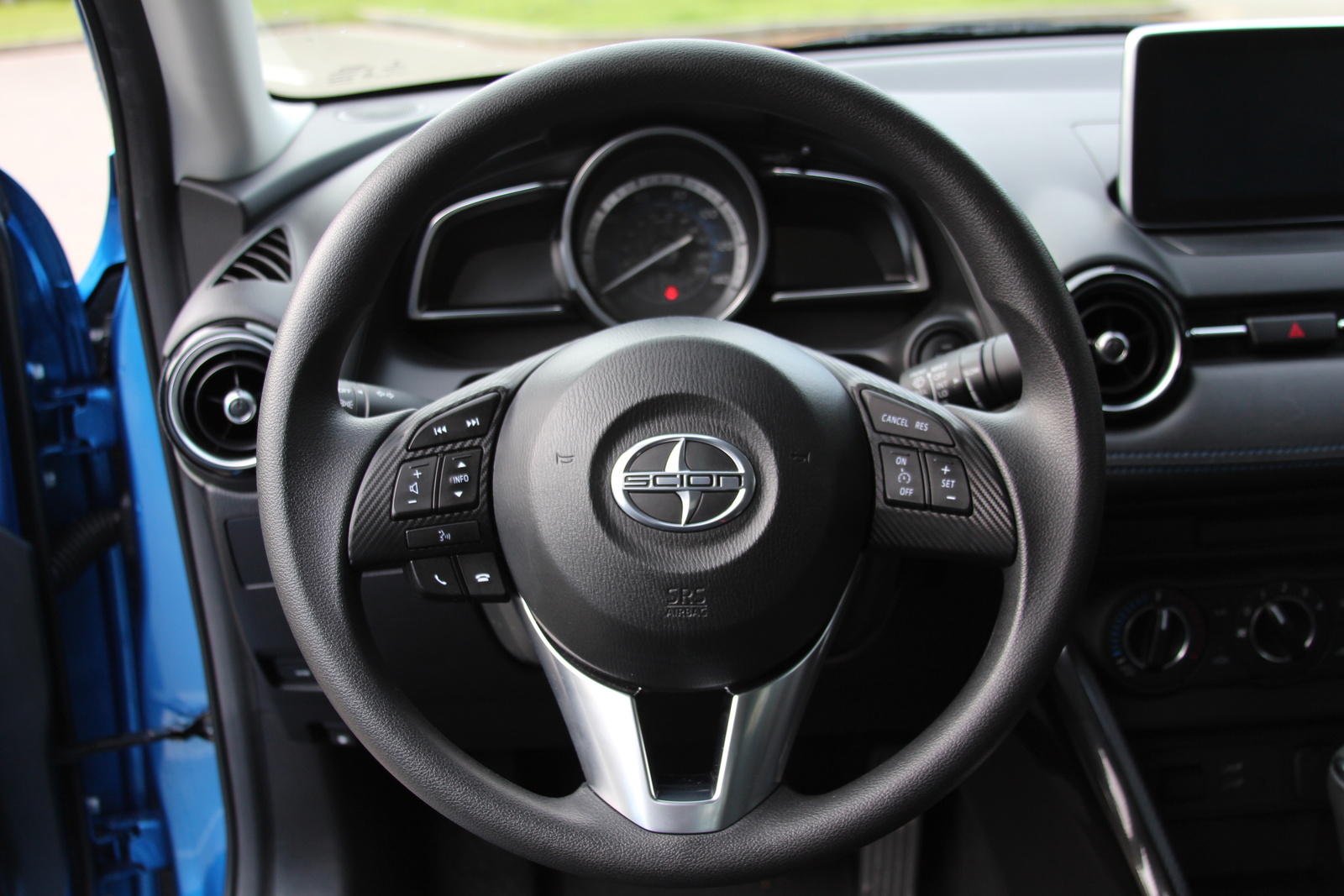
The fact that the iA has a hard time delivering its advertised 37-mpg combined rating has to count against it here, but it’s still a competent economy performer, especially on flatter terrain and with less time spent spooling through canyons. More than that, it’s a comfortable car that shows a level of refinement you wouldn’t expect at the price. While I feel the 7-inch touchscreen sits rather obtrusively on the otherwise classic and handsome dash layout, it functions well with a simple i-Drive-style controller and some interesting design features in the interface. Unique touches like the radial selection screen for radio stations are something you don’t generally see in infotainment interfaces, and it’s a welcome, fresh approach to what can be a very boring aspect of car ownership.
While the back seat doesn’t garner any praise for overwhelming space, it’s wholly adequate for a subcompact sedan. It seems that most of the iA’s space has gone to the trunk, and at 13.5 cubic feet, it’s a much more usable allocation, especially for the class where that number makes the iA a standout. Couple that with elements like a standard tilt-and-telescoping steering wheel, 16-inch alloys, and push-button start, and you’re getting a lot more than what you’d expect from an economy subcompact — and that’s before we get to technology!
Tech Level
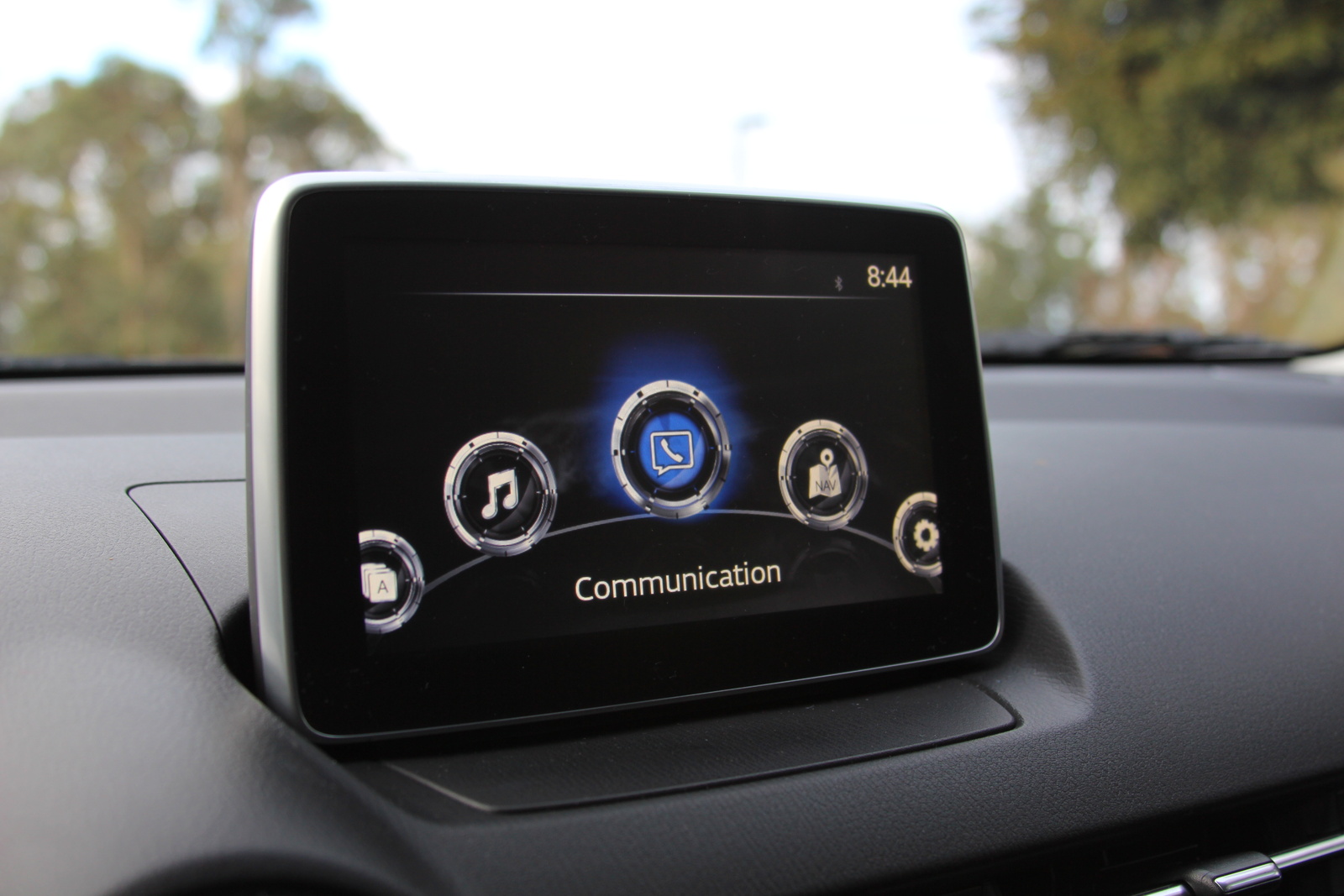
Believe it or not, the iA shines here as well. While you’ll have to pay $419 to add navigation, the iA comes otherwise very well equipped. The 7-inch touchscreen and dial controller work better than most, and two USBs mean you won’t fight with passengers for phone-charging rights. Plus it comes with all the usuals like streaming radio, USB, Bluetooth, and voice recognition. A backup camera is a welcome addition two years before federal regulations require it, even if it’s not wholly necessary in a car with visibility as open as the iA’s. But the real noteworthy addition here is a low-speed forward-collision warning system that utilizes automatic braking between 2 and 18 mph to avoid accidents. This is a feature that’s usually relegated to the option lists of luxury vehicles, and here it’s standard. Well done, Mazda/Scion.
Safety
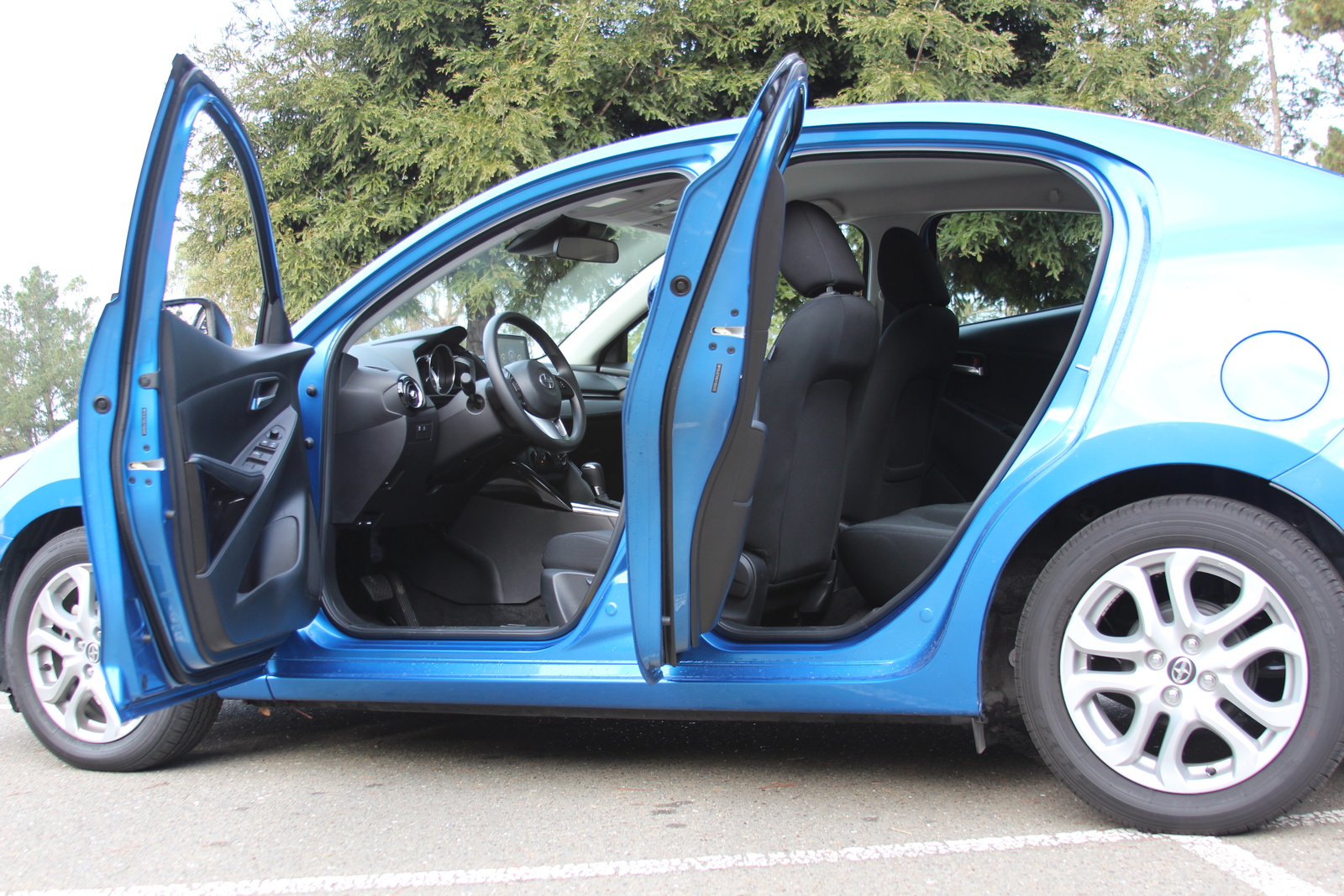
The iA comes with front disc and rear drum brakes, which are more than adequate for a car of this weight, however with economy tires its 60-0 braking distance is a rather disappointing 125 feet. With stickier tires, this would be much improved, although you’d sacrifice some mileage. With the low-speed forward-collision warning system, some additional props are deserved here, and the standards of traction and stability control are of course included. Front, side, and curtain airbags are included for both driver and passenger as well.
Unfortunately, the iA has not been tested by either the National Highway Traffic Safety Administration (NHTSA) or the Insurance Institute for Highway Safety (IIHS). But the car upon which the iA is based — the 2014 Mazda2 — is offered for sale in other markets and has been tested. The IIHS awarded it the top rating of Good for frontal-offset and roof-strength tests, but side and rear crash tests earned only an Acceptable rating. Even worse, small-overlap frontal crash tests saw a Marginal score, which is one better than Poor. The Euro New Car Assessment Program (ENCAP) gave it an overall rating of 4 out of 5 stars, while the Australasian New Car Assessment Program (ANCAP) gave it 5 out of 5.
Cost-Effectiveness
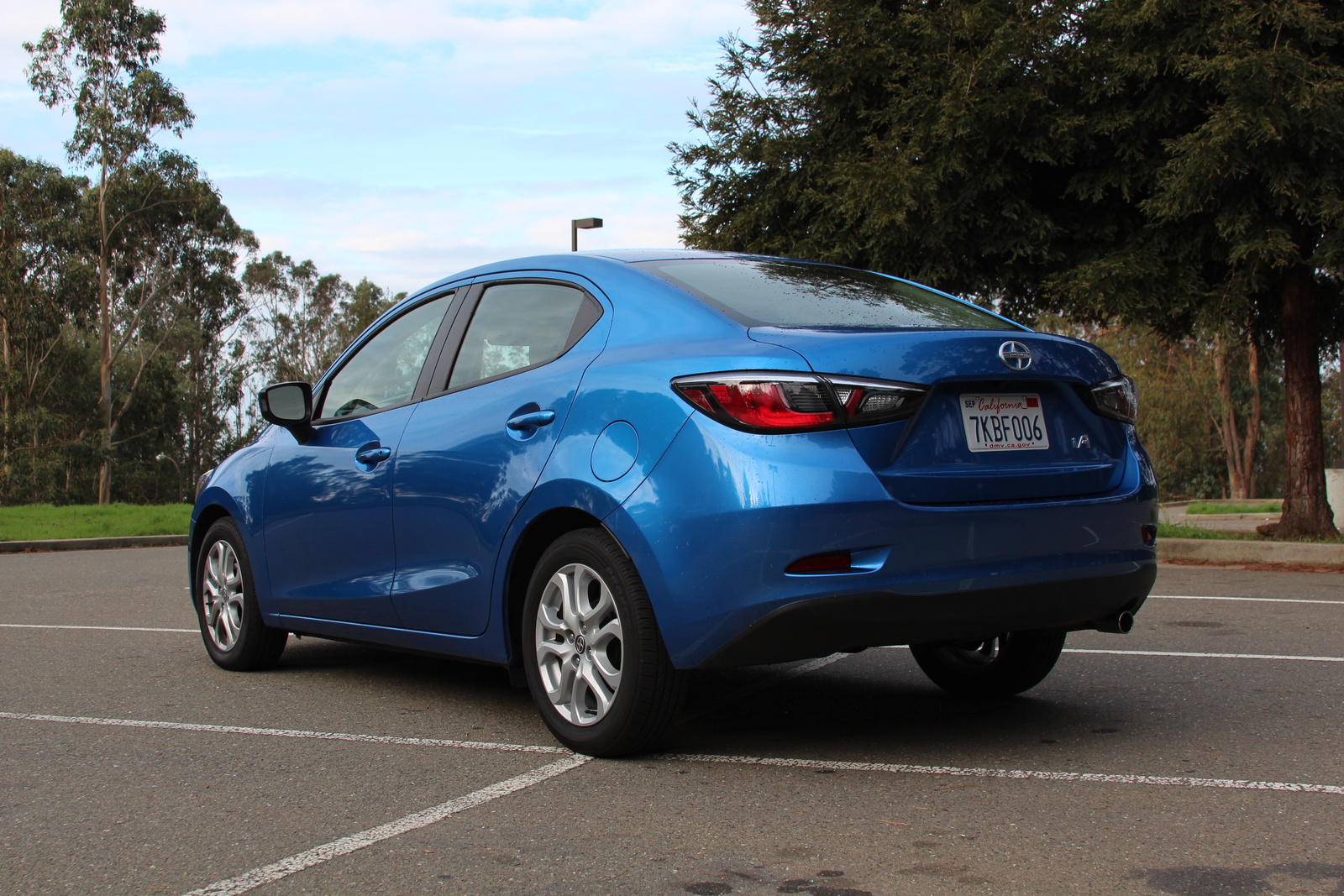
A $17,000 MSRP puts the iA in a very competitive place. While options like the Honda Fit offer more space and the Ford Fiesta offers an even better driving experience, the iA pushes right down the middle for a strong selection in both categories. However, the news this February that Toyota will discontinue the Scion brand is sure to affect resale value down the line.
A CarGurus contributor since 2008, Michael started his career writing about cars with the SCCA — winning awards during his time as editor of Top End magazine. Since then, his journalistic travels have taken him from NY to Boston to CA, completing a cross-country tour on a restored vintage Suzuki. While his preference is for fine German automobiles — and the extra leg room they so often afford — his first automobile memories center around impromptu Mustang vs. Corvette races down the local highway, in the backseat of his father’s latest acquisition.
2016 Scion iA Pros and Cons: Why (Not) This Car?
Sign in or join to like this review.
Introduction
As you might have heard, Scion, Toyota’s youth-oriented brand, is in its final model year despite having just introduced two new models. Come 2017 the car I’m reviewing here will likely be sold as the Toyota Yaris sedan, as it already is in Canada.
As you also might have heard, the iA / Yaris sedan isn’t actually a Toyota. Instead, it’s a Mexican-made Mazda2 with a different face. Mazda didn’t feel they could sell enough of these small, «B-segment» cars in the United States and Canada, so they gave distribution rights for the sedan (North America doesn’t get the hatchback at all) to another company whose brand reputation and larger dealer network give them a better shot. Mazda has kept the related but considerably more expensive (and thus profitable) CX-3 crossover for its own dealers.
Since Mazda didn’t see much point in selling the iA itself, and the small sedan wasn’t enough of a success to save Scion, should you see much point in buying one?
The designers must have struggled to make Mazda’s current curves work with stubby proportions. more iA photos
The iA’s interior is also all Mazda aside from the Scion emblems. Very nicely done for the price.
Tested: 2016 Scion iA
Compared: 2014 Ford Fiesta
Why the 2016 Scion iA?
Since the Scion iA was designed and engineered by Mazda, I expected it to handle well. I was not disappointed. Perhaps to adapt the car for Scion, the iA’s suspension isn’t quite as firm as that of small Mazdas tends to be, and its steering doesn’t feel sharp on center. But bend the small sedan into a curve, and its steering and suspension become communicative and responsive, with minimal understeer, moderate lean, and excellent controllability.
With a curb weight just over 2,400, the iA is two-to-three hundred pounds lighter than competitors from GM, Ford, Hyundai, and Kia, and the difference from the driver seat feels even larger. Though not a sport sedan, it’s the most agile car in the class, and fun to drive.
The Fiesta also handles well, but has noticeably softer tuning and feels a little sloppier in transitions.
The Scion iA’s light weight also pays fuel economy dividends. EPA ratings of 31/41 with the manual transmission and 33/42 with the automatic (both with six ratios) are best-in-class, with one partial exception. With a turbocharged 1.0-liter three-cylinder engine the Ford Fiesta manages 31/43, but this engine is a $1,000 option and is available only with a five-speed manual transmission. With its standard 1.6-liter engine, the Fiesta manages only 28/36 with a manual and 27/37 with an automatic.
In my real-world suburban driving the trip computer often reported averages over 40 mpg, though driving the car like the typical American sunk the average all the way into the mid-30s. On a 70-mph highway with the temperature right at freezing (not ideal) the trip computer reported a two-way average of 44 mpg.
Driven with a very light foot, the Fiesta EcoBoost (with the turbocharged triple) can achieve a suburban average in the low 50s, and averages in the mid-40s aren’t too difficult. But push the Fiesta and the average will fall into the 30s and even the upper 20s. Fuel economy does tend to vary more with turbocharged engines, as the turbo serves to force more air (and with it more fuel) into the cylinders when this is called for. Most drivers will observe real-world fuel economy as good or better in the Scion iA.
Then there’s the Mazda3. Though larger and considerably more powerful than the iA, it achieves EPA ratings that are nearly as good, 29/41 with a manual transmission and 30/41 with an automatic. Step up to the truly quick Mazda3 s, with an engine a full liter larger than the iA’s (2.5 vs. 1.5 liters), and with an automatic the EPA ratings remain too close for comfort, 28/39. Once the figures get to this level, you tend to give up more in performance than you gain in fuel economy.
The iA’s fluid lines are all Mazda.
Well designed controls, but washed-out tachometer. The glare in the photo was often present.
The Scion iA aced its crash tests. With the exception of the Chevrolet Sonic, competitors didn’t do as well in the challenging small overlap test. The Versa sedan even scored a poor.
Bear in mind, though, that these tests tend to assume a collision with a vehicle of the same weight as the tested car, so their results only apply when comparing cars that are about the same weight.
The iA is unique within the class in having a low-speed automatic braking system as standard. In the 12-mph IIHS test, this system completely stopped the iA in time to avoid a collision. It would be nice if the iA also had a standard forward collision warning system and an auto-braking system that operated at higher speeds, but neither is available. You can get the Chevrolet Sonic with forward collision warning, a feature I highly recommend.
The iA also has a standard rearview camera.
Compared to other small sedans, the Scion iA has a stylish, well-finished interior. Though many surfaces are hard plastic, they don’t look or feel cheap. Some interesting textured trim helps. A strip of padded upholstery with blue stitching across the face of the instrument panel, also present in the Mazda CX-3, takes the ambiance up a notch or two.
The Ford Fiesta also has one of the nicest interiors in the class, so this one’s pretty much a tie.
The instrument panels in both the Ford Fiesta and Chevrolet Sonic are overly tall and deep. In contrast, the driving position and view forward in the Scion iA are nearly ideal.
Some people dislike the appearance of an infotainment screen perched on top of the instrument panel like an afterthought. But this location places the display where it is most easily and safely viewed without requiring that the entire instrument panel be as high.
Why Not the 2016 Scion iA?
The iA’s exterior styling is pleasant enough until you get to the Scion / Toyota face. When you look at it, what do you see?
Though I tested the Fiesta hatch, in this area I’m rating the iA against the Fiesta sedan. I find the Ford Fiesta attractive as a hatchback. As a sedan, not nearly as much. It doesn’t wear a trunk well.
Sitting behind my 5-9 self in the Scion iA, I have about an inch of knee room, which is an inch more than I have in the Fiesta. While other small sedans don’t tend to be much better, the Nissan Versa has a far roomier rear seat.
Note that while a car must be nearly the best if not the best in an area to warrant a «why to buy,» it doesn’t have to be nearly the worst to warranty a «why not to buy,» only not good.
This face was Toyota’s contribution to the iA / Yaris. Mazda supplied the rest.
Tight back seat. Also a bit buried due to the upsweeping side windows.
Beyond the choice of a manual or automatic transmission, the Scion iA comes equipped only a single way from the factory. While the base equipment level is high for this size car, with alloy wheels, a rearview camera, low-speed auto-braking, and a nav-ready infotainment system, if you want a sunroof, leather upholstery, or heated seats you’re out of luck. You can’t get these features with the EcoBoost version of the Fiesta, either, but you can get them with the Ford’s other engine options (including the 197-horsepower ST).
Other features of the 2016 Scion iA
The Scion iA’s 106-horsepower 1.5-liter four-cylinder engine feels thoroughly adequate in typical daily driving. Call upon it for all its got, though, and you’ll learn it hasn’t got much more. The engine has a solid midrange, but not much of a top end. Running from a stop to 60 mph with the pedal to the floor takes nearly ten seconds, a time considered quick back in the 1980s but sluggish by current standards. While none of the other sedans in the class is much quicker, even though some have over thirty more horsepower, the optional turbocharged engines in the Chevrolet Sonic and Ford Fiesta have stronger midranges and feel more relaxed in typical driving, as they don’t have to rev as much.
The Mazda-supplied automatic is among the best, almost seeming to read your mind with quick yet smooth shifts. I’d still prefer the manual because it provides a more direct connection, making the car seem quicker than it actually is and more fun to drive. The shifter satisfies with solid, precise, relatively short throws, but can make a clanging sound, as if it’s bolted directly to the floorpan. A little more refinement wouldn’t hurt here.
The Scion iA rides more smoothly and quietly than the Honda Fit, with road noise only somewhat loud in the rain (the wheel wells don’t seem to be thoroughly insulated). But the Ford Fiesta and Chevrolet Sonic both seem more substantial and quieter (partly because they are more substantial), like more upscale cars. Even the much larger Mazda6 feels like it’s lightly built, an agile rather than a rock-solid, insulated car. It’s a Mazda thing.
The Scion iA’s infotainment interface, like that in recent Mazdas, mimics the console-centric systems in Audis and BMWs to good effect. If I was evaluating just this interface, plus the classic three-dial HVAC controls, you’d find «controls and instruments» among the «why to buys.» But the LCD tach difficult to read at a glance and often washes out in sunlight. While this isn’t much of an issue with an automatic transmission, it is one with the manual.
The Fiesta suffers from a Ford of Europe interface that borders on incomprehensible for at least one American.
| Reliability & durability |
Reliability could easily end up among the Scion iA / Yaris sedan’s «why to buys,» as other recent Mazdas have tended to be reliable. At this point, though, we have no reliability data on the car.
The Ford Fiesta hasn’t had a good reliability record. A major source of problems can be avoided by getting one with a manual transmission.
Scions have no factory options other than the transmission, only dealer-installed accessories. So an iA’s pricing is simple: $16,495 with a manual and $17,595 with an automatic. Want nav? You can purchase an SD card for about $400 from either Mazda or Toyota dealers (the latter’s price is a little higher).
Competitors can start well below the iA, but once similarly equipped usually end up in the same ballpark. A Ford Fiesta SE is $300 less than the iA with its base engine, and $695 more with the more efficient, torquier turbo three-cylinder. The Fiesta also has about $400 in additional content (including automatic headlights, a leather-wrapped steering wheel, a CD player, an armrest, and floormats).
The Nissan Versa is an exception. Only in its base trim, which is priced $3,680 below the Scion, is the Versa offered with a manual transmission. Equip the iA with an automatic, and the mid-level Versa SV is $1,240 less, with about $300 of the difference attributable to content differences. Also factor in that Scion dealers employ «pure pricing.» Prices can be discounted from MSRP, but the same discount is offered to everyone, with no room for negotiation. Owing to this policy, the actual price difference has tended to be larger, which does a lot to explain why the Versa is class best seller.
The real challenge, though, comes from the larger and much more powerful, yet nearly as fuel-efficient Mazda3. The Mazda lists for $2,170 more, a significant amount, but you get a lot more car. Mazda itself didn’t think the Mazda2 / iA would do well in the same showroom.
Since it has been annouced that Scion is in its final model year, dealers might be discounting them more. When the iA is rebranded a Toyota next year its price will be negotiable. I don’t expect resale values to be affected much. Pontiac Vibes remain in strong demand because they’re widely known to really be Toyotas.
Conclusion
The Scion iA isn’t the cheapest, quickest, roomiest, or most luxurious small sedan. But it is the most agile and fuel efficient, has a well-designed interior, and should be reliable. For someone seeking a fun car with a low total cost of ownership, it’s a very strong contender. But if you have another $2k to spend, you should also consider the larger and more powerful yet nearly as fuel-efficient Mazda3.
Decent power for typical daily driving, but not much in reserve. Efficient.
Trunk about average in size, 12 cubic feet. Rear seat folds in two sections.
Scion provided an insured car with a manual transmission for a week with a tank of gas, an earlier iA with an automatic transmission at a regional media association event.
Response from scumbling1
2:15 pm April 18, 2016
How about the sound and feel of the engine? Does it feel eager to work, or more like hate it’s existence?
Response from mkaresh
6:54 pm April 18, 2016
Neither, really. Nother notably objectionable or praiseworthy about the sound of it. As noted in the review, it feels fairly torquey in typical driving, but push it harder and there’s not much more there. I didn’t run it to the red line for thrills.
Response from teamsc10190
2:40 pm April 20, 2016
Toyota has managed to handicap Mazda’s distinctiveKodo design language with a carp-faced visage that to my eyes is a cut and paste design travesty.
Juxtaposed against the current Toyota Yaris, the Scion iA is an improvement of truly epic proportions and perhaps that’s the best comparison to help appreciate what an asset the iA brings.
A key point concerning Mazda’s decision to provide the Mazda 2 to Toyota is that Toyota’s projected volumes of 50K/yr.provides Mazda with instantaneous capacity utilization for their new Salamanca plant.
Response from Member6724
1:34 pm April 22, 2016
Michael, I’m surprised to see you rate the powertrain as only even with the Fiesta. Since most buyers buy automatic, wouldn’t the Fiesta’s inferior automatic transmission performance give the Mazsciota the edge?
Response from mkaresh
2:12 pm April 22, 2016
I rate the cars that were tested, in this case with manual transmissions.
2016 Scion iA: A Mazda 2 Sedan with a Scion Badge
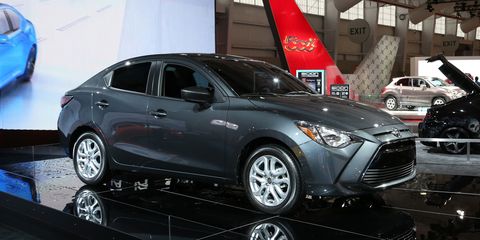
Scion’s stagnant lineup is about to get an injection of fresh metal, and among the new products is what the company is calling its first sedan. (There’s also the new iM hatchback.) The thing about the iA is that it isn’t really a Scion, or even a Toyota for that matter. It’s quite literally a 2016 Mazda 2 sedan—a body style of the 2 we won’t get here—inside and out. The only differences are the badges, the carp-like front fascia, the headlamps, and some minor differences in the taillamp innards. That’s it.
You may remember that the next Toyota Yaris will be based on the Mazda 2 and that the cars will be built alongside one another at Mazda’s Salamanca, Mexico, plant starting later this year. We also knew that the Toyota would use the 2’s Skyactiv engine, but the iA’s arrival shows even more depth to the collaboration, as the Scion is a Mazda through and through, right down to its body panels, instruments, steering wheel, and seat fabrics.
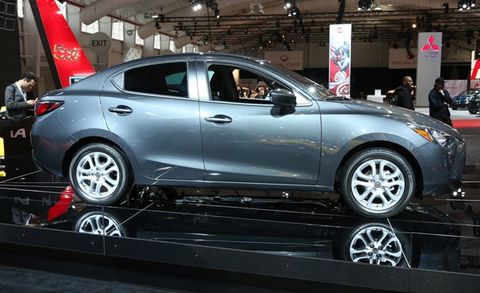
As you’d expect, then, the sole engine for the iA is Mazda’s 1.5-liter Skyactiv four-cylinder, although it won’t wear Skyactiv branding under the Scion’s hood. With direct injection and a 12.0:1 compression ratio, the powerplant produces 106 horsepower at 6000 rpm and 103 lb-ft of torque at 4000 revs; it will be offered with a choice of six-speed manual or automatic transmissions. That’s hardly hellacious power, but it shouldn’t have much trouble moving the iA, given Scion’s claimed curb weights of 2385 pounds for the manual model and 2416 for the automatic. Even better for small-car buyers is the car’s impressive estimated fuel economy: 31/41 mpg city/highway for the manual, 33/42 for the automatic.
With one configuration and an expected MSRP of about $16,000, according to Scion, the iA won’t be underequipped, either. Standard goodies include 16-inch aluminum wheels, turn-signal repeaters in the side mirrors, and a forward-collision warning system. The interior is loaded up with cruise control, air conditioning, keyless entry, push-button ignition, a backup camera, and—in a fun twist for Scion sales training—Mazda’s seven-inch infotainment system screen and knob interface. Being a Scion, a full raft of dealer-installed accessories will be available, too.

Perhaps best of all is that we’ve been told by Scion that the tuning of the iA’s front-strut/rear-torsion-beam suspension and electronic power steering will be no different from the Mazda’s, which means the iA probably won’t be awful to drive. We won’t know until we get behind the wheel, of course, but we are optimistic given Mazda’s latest string of products.


